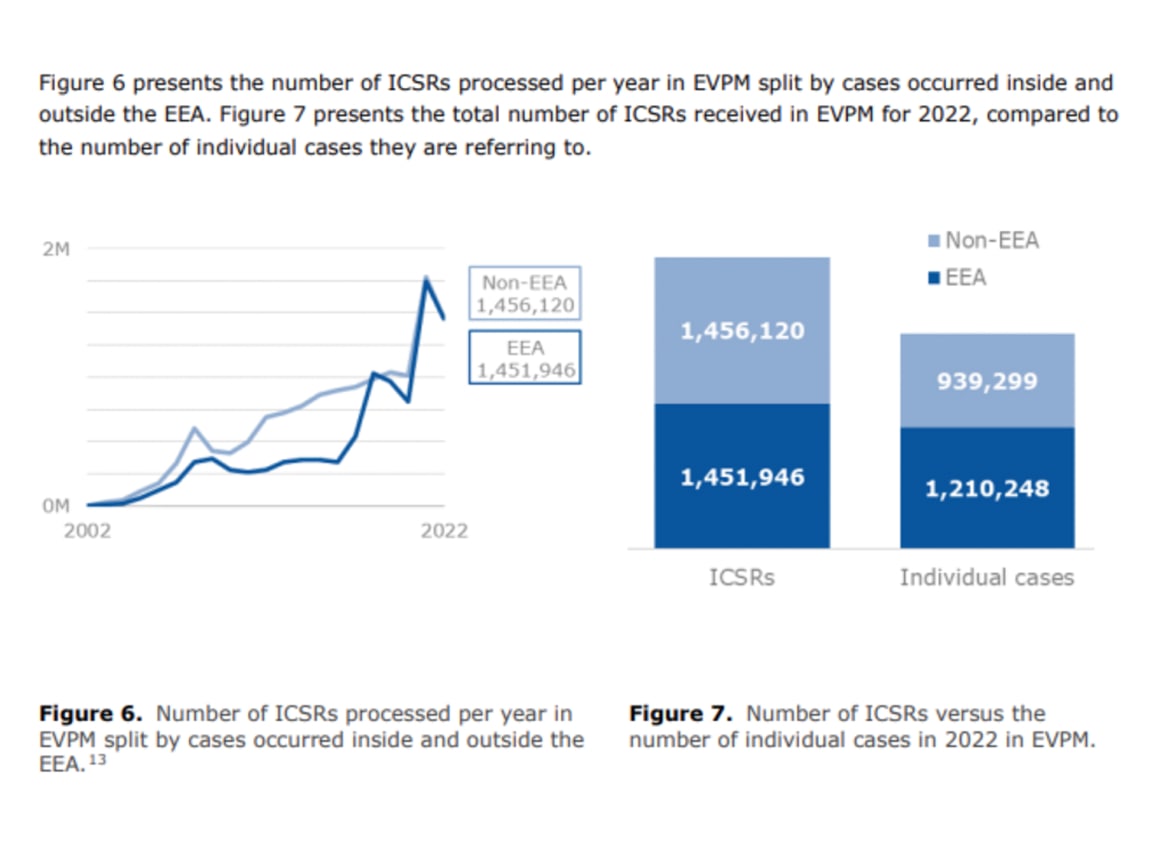Vragen aan EMA

💨
Bijlage bij artikel Toine de Graaf over Wouter Aukema
Bijlage bij artikel Toine de Graaf over Wouter Aukema
Datum: 27 november 2022
Gezondheid
Toine de Graaf

-In downloading ICSRs each week, Aukema observes in the downloads that approximately 40% of the ICRSs from previous weeks, no longer appear in (recent) downloads. Can EMA confirm his observation? Can this be explained as the result of deduplication of cases into master cases?
-In downloading case safety form EU-EC-10012115354 on July 22, 2022 the patient age group was specified as 18-64 years. When downloading this form a while later on 19-sep-2022, the age group appeared empty and the sender organisation had changed from Astrazeneca PLC to Astrazeneca Public. How often do retroactive modifications of ICRSs take place? Who performs these modifications?
-In the 2022 annual report of the EMA (https://www.ema.europa.eu/en/documents/annual-report/2022-annual-report-european-medicines-agency_en.pdf) EMA reports 2.9 millions ICSRs were received in 2022. A distinct count of the number of EU Local Numbers in the line listings obtained for all products and substances from Eudravigilance, shows 1,683,470 unique ICSRs (downloaded 24-oct-2024). Can EMA confirm that there are 1,683,470 unique cases in adrreports.eu, for 2022?
Reactie van EMA:
We would like to highlight that the information provided on www.adrreports.eu aims to inform healthcare professionals and the general public on suspected adverse reactions reported for specific medications. However, this information is not enough for the general public to perform a technical audit of the system. Spontaneous reporting systems like EudraVigilance are very complex and require dedicated staff with strong knowledge of pharmacovigilance, otherwise it is very easy to draw wrong conclusions. For this reason, EMA has seen many misinterpretations and plenty of miscalculations in the number of cases leading to the wrong conclusions when a member of the public tried to download in bulk all the data in relation to the Covid-19 vaccines. In other words, the tools to export the data on the ADR reports website and the actual data publicly available for each report are not optimal for these types of exercises which do not serve the purpose and the objective the ADR reports website was built for.
Considering the above, EMA cannot validate results of analysis that a member of the public performs with an unknown methodology and unknown tools to retrieve the data, but we can confirm that the cases do not diappear from the database and the cumulative number of cases for the Covid-19 vaccines has constantly increased since the approval of the first vaccine in December 2020.
In EudraVigilance, EMA is the secondary receiver of data, which means that the Agency cannot modify the original source reported data. Any updates are based on information submitted to us from the reporter. We only aggregate and visualise data submitted to EudraVigilance.
For example, if a case is submitted as fatal, we cannot downgrade it to non-fatal or non-serious. Furthermore, the Agency cannot nullify any cases submitted by sender organisations. That can be performed only by these organisations in the situations when the cases have been submitted by error. Specific issues that have been perceived or interpreted by the general public as direct modifications from EMA are in fact due to the flow and the cycle of spontaneous reporting (e.g. follow-ups, management of duplicate notifications) and regular maintenance of the database. When there is a follow-up of an initial case, the follow-up case is allocated to a different EU local number, so the cases do not ‘disappear’ from the database they are simply recorded under a different EU local number. Aggregated analysis of cases based on the EU local numbers can only lead to misinterpretations.
More specifically and to explain modifications of numbers due to duplicate management, as part of the data management activities, EMA is constantly performing duplicate detection in EudraVigilance. When two cases are identified as duplicates, they are merged into a single case and only this master case is available to the users. The duplicates management activities trigger changes in the specific number of cases. In the background information published on the ADR website we provide explanations about why the number of cases can even decrease with time, and this is due to follow-ups, nullifications and duplicate reports (https://www.adrreports.eu/en/data_quality.html).
Regarding the question about case EU-EC-10012115354 and the population of the patient age, when the age of the patient is not reported but other parameters to calculate the age are reported, then EMA makes calculations of the age and populates the age in the data visualisations tools, this is with the intention the enhance the visualisation of the data. To calculate the age (if not reported by the primary source), the EMA takes into considerations the date of birth (when reported) and the date of the reaction (when reported), but if the date of the reaction was not reported, the EMA considered in the past the report received date in order to calculate the maximum possible age. This calculation using the received data led to some misunderstandings in the past and the EMA decided to change the algorithm to calculate the age and the received date is not considered any longer.
For EU-EC-10012115354, the patient’s age is not reported by the primary source, the date of birth is reported, but the reaction date is not reported and that is why the age group is not populated any longer in the data outputs. This is the reason why the patient age group was populated in the past and it is not populated any longer following the explained modification of the algorithm driven by the business needs.
With regard to the population of the sender in the same case EU-EC-10012115354, the sender information is taken from the Organisation Management System. AstraZeneca changed their name from AstraZeneca PLC to AstraZeneca Public Limited Company; the field in the ICSR form has a character limit and that is the reason why only the denomination ‘AstraZeneca Public’ appears. This is an administrative change driven by the right of the Marketing Authorisation Holders to modify their administrative data; this modification does not have any implication on the safety of Covid-19 vaccines.
The data provided in the 2022 EV annual report is correct. It is important to highlight the difference between ICSR transmissions and the number of individual cases. One individual case can be formed by more than one ICSR transmission, if after the initial report there are follow-ups. Find here the information from the EV annual report of 2022 where it is clearly explained the number of ICSR transmissions and the number of individual cases. Be also aware that EudraVigilance is updated every single day, and it is a very dynamic database, therefore retrieving the data on different dates or even different years for the data received in 2022 will lead to different specific numbers due to the normal workflow of information. Another specificity important to understand is that the EV annual report provides data based on the EudraVigilance post-marketing module and the ADR reports website provides data on spontaneous reports as stated in the EudraVigilance access policy.
Wil je meer weten?
Wil je meer weten?
 Koop de nieuwste editie bij jou in de buurt, of bestel deze editie.
Koop de nieuwste editie bij jou in de buurt, of bestel deze editie.